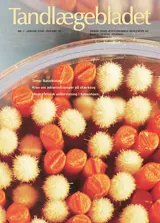Genetiken bakom medfödd avsaknad av tänder
Under det senaste decenniet har vår kunskap om de mekanismer och den genetik som ligger bakom tandutvecklingen ökat enormt. Genom molekylär genetiska och djurexperimentella utvecklingsstudier på möss har mekanismerna bakom såväl den tidiga tandutvecklingen som differentieringen av de celler som producerar hårdvävnaden kring tänderna blivit mycket klarare. Det har visat sig att tänderna under sin utveckling i stor utsträckning använder sig av liknande interaktio ner och molekylära mekanismer som andra organ. Den ärftliga bakgrunden till avsaknad av tänder hos människan har visat sig vara synnerligen heterogen. En av framtidens utmaningar blir därför att identifiera orsakerna till de lindrigare former av hypodonti som är vanliga inom befolkningen. Man har konstaterat att medfödd avsaknad av tänder i vissa fall kan vara en indikator för en ökad cancerrisk vilket ytterligare framhäver vikten av att utreda orsa kerna till olika former av tanddefekter.
Genetics of tooth agenesis: During the last decennium, understanding of the developmental and genetic mechanisms of tooth formation has greatly increased. Applying molecular genetics to human dental malformations and using mouse teeth as a model in experimental studies, it has become obvious that mechanisms of tooth development closely parallel those of other organs. Unraveling of the genetic basis of tooth agenesis, the most common malformation in man, contributes to the understanding of developmental and evolutionary mechanisms shared by teeth and other organs, and it may have important implications for clinical dentistry. Genetic and molecular analysis of isolated and syndromic tooth agenesis has revealed several mutated genes, implying that the genetic background for tooth agenesis is extremely heterogeneous. Mutations in three genes, MSX1, PAX9 and AXIN2, usually only affect dentition, causing severe type of tooth agenesis (oligodontia). However, the patterns of missing teeth associated with these mutations are different for each gene. Inter‑ estingly, mutations in AXIN2 also predispose to colorectal cancer, underlying the similarity of genetic mechanisms of tooth development and regulation of tissue homeostasis, and suggesting that tooth agenesis in some cases may be an indication for increased susceptibity to cancer. From the mutations that so far have been identified because dominant oligodontia or syndromic tooth agenesis, it is plausible that sequence variants in the same genes may contribute to other, more common types of tooth agenesis.


